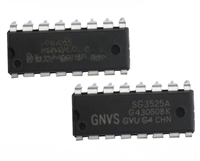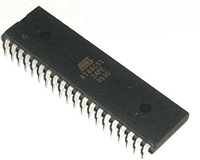ADM7170
Data Sheet
Thermal overload protection is included, which limits the
junction temperature to a maximum of 150°C (typical). Under
extreme conditions (that is, high ambient temperature and/or
high power dissipation) when the junction temperature starts to
rise above 150°C, the output is turned off, reducing the output
current to zero. When the junction temperature drops below
135°C, the output is turned on again, and the output current is
restored to its operating value.
Table 7. Typical θJA Values
Copper Size (mm2)
θJA (°C/W) of LFCSP
251
100
500
1000
6400
165.1
125.8
68.1
56.4
42.1
1 Device soldered to minimum size pin traces.
Consider the case where a hard short from VOUT to ground
occurs. At first, the ADM7170 current limits, so that only 3 A is
conducted into the short. If self heating of the junction is great
enough to cause its temperature to rise above 150°C, thermal
shutdown activates, turning off the output and reducing the output
current to zero. As the junction temperature cools and drops
below 135°C, the output turns on and conducts 3 A into the
short, again causing the junction temperature to rise above
150°C. This thermal oscillation between 135°C and 150°C
causes a current oscillation between 3 A and 0 mA that
continues for as long as the short remains at the output.
The junction temperature of the ADM7170 is calculated from
the following equation:
TJ = TA + (PD × θJA)
where:
(2)
TA is the ambient temperature.
PD is the power dissipation in the die, given by
PD = [(VIN − VOUT) × ILOAD] + (VIN × IGND
)
(3)
where:
I
LOAD is the load current.
IGND is the ground current.
Current-limit and thermal limit protections are intended to
protect the device against accidental overload conditions. For
reliable operation, device power dissipation must be externally
limited so that the junction temperature does not exceed 125°C.
VIN and VOUT are the input and output voltages, respectively.
Power dissipation due to ground current is quite small and can
be ignored. Therefore, the junction temperature equation
simplifies to the following:
THERMAL CONSIDERATIONS
TJ = TA + (((VIN − VOUT) × ILOAD) × θJA)
(4)
In applications with low input-to-output voltage differential, the
ADM7170 does not dissipate much heat. However, in applications
with high ambient temperature and/or high input voltage, the
heat dissipated in the package may become large enough that
it causes the junction temperature of the die to exceed the
maximum junction temperature of 125°C.
As shown in Equation 4, for a given ambient temperature, input-
to-output voltage differential, and continuous load current, a
minimum copper size requirement exists for the PCB to ensure
that the junction temperature does not rise above 125°C. Figure 63
to Figure 65 show junction temperature calculations for differ-
ent ambient temperatures, power dissipation, and areas of PCB
copper.
When the junction temperature exceeds 150°C, the converter
enters thermal shutdown. It recovers only after the junction
temperature has decreased below 135°C to prevent any permanent
damage. Therefore, thermal analysis for the chosen application
is very important to guarantee reliable performance over all
conditions. The junction temperature of the die is the sum of
the ambient temperature of the environment and the tempera-
ture rise of the package due to the power dissipation, as shown
in Equation 2.
155
145
135
125
115
105
95
85
75
To guarantee reliable operation, the junction temperature of
the ADM7170 must not exceed 125°C. To ensure that the
junction temperature stays below this maximum value, the
user must be aware of the parameters that contribute to
junction temperature changes. These parameters include
ambient temperature, power dissipation in the power device,
and thermal resistances between the junction and ambient air
(θJA). The θJA number is dependent on the package assembly
compounds that are used and the amount of copper used to
solder the package GND pin to the PCB.
65
55
45
35
25
2
6400mm
2
500mm
2
25mm
T
MAX
J
0
0.2 0.4 0.6 0.8 1.0 1.2 1.4 1.6 1.8 2.0 2.2 2.4 2.6 2.8 3.0
TOTAL POWER DISSIPATION (W)
Figure 63. LFCSP, TA = 25°C
Table 7 shows typical θJA values of the 8-lead LFCSP package for
various PCB copper sizes. The typical value of ΨJB is 15.1°C/W for
the 8-lead LFCSP package.
Rev. C | Page 20 of 23






 SG3525资料手册详解:SG3525参数分析、引脚说明、应用介绍
SG3525资料手册详解:SG3525参数分析、引脚说明、应用介绍

 AT89C51单片机资料手册详细解析及应用示例
AT89C51单片机资料手册详细解析及应用示例

 CP2102资料手册解读:CP2102引脚说明、关键参数分析
CP2102资料手册解读:CP2102引脚说明、关键参数分析

 资料手册解读:UC3842参数和管脚说明
资料手册解读:UC3842参数和管脚说明
